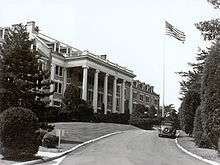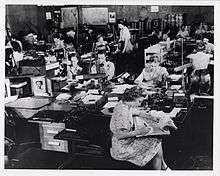Arlington Hall

Arlington Hall (also called Arlington Hall Station) was a former girls' school and the headquarters of the United States Army's Signal Intelligence Service (SIS) cryptography effort during World War II. The site presently houses the George P. Shultz National Foreign Affairs Training Center, and the U.S. National Guard Readiness Center. It is located on Arlington Boulevard (U.S. Route 50) between S. Glebe Road (State Route 120) and S. George Mason Drive in Arlington, Virginia.
History


"Arlington Hall" was founded in 1927 as a private post-secondary women's educational institution, which, by 1941, resided on a 100-acre (0.40 km2) campus and had acquired the name "Arlington Hall Junior College for Women". The school suffered financial problems in the 1930s, and eventually became a non-profit institution in 1940.[1] On June 10, 1942, the U.S. Army took possession of the facility under the War Powers Act for use by its Signals Intelligence Service.[2]
During the War, Arlington Hall was in many respects similar to Bletchley Park in England, only one of two primary cryptography operations in Washington (the other was the Naval Communications Annex, also housed in a commandeered private girls' school). Arlington Hall concentrated its efforts on the Japanese systems (including PURPLE) while Bletchley Park concentrated on European combatants.
The Arlington Hall effort was comparable in influence to other Anglo-American WW II-era technological efforts, such as the cryptographic work at Bletchley Park, the Naval Communications Annex, development of sophisticated microwave radar at MIT's Radiation Lab, and the Manhattan Project's development of nuclear weapons.
After World War II, the "Russian Section" at Arlington Hall expanded. Work on diplomatic messages benefited from additional technical personnel and new analysts—among them Samuel Chew, who had focused on Japan, and linguist Meredith Gardner, who had worked on both German and Japanese messages. Chew had considerable success at defining the underlying structure of the coded Russian texts. Gardner and his colleagues began analytically reconstructing the KGB codebooks. Late in 1946, Gardner broke the codebook's "spell table" for encoding English letters. With the solution of this spell table, SIS could read significant portions of messages that included English names and phrases. Gardner soon found himself reading a 1944 message listing prominent atomic scientists, including several with the Manhattan Project. Efforts to decipher Soviet codes continued under the classified and caveated Venona project.
Another problem soon arose—that of determining how and to whom to disseminate the extraordinary information Gardner was developing. SIS's reporting procedures did not seem appropriate because the decrypted messages could not even be paraphrased for Arlington Hall's regular intelligence customers without divulging their source. By 1946, SIS knew nothing about the federal grand jury impaneled in Manhattan to probe the espionage and disloyalty charges stemming from Elizabeth Bentley's defection and other defectors from Soviet intelligence, so no one in the US Government was aware that evidence against the Soviets was suddenly developing on two adjacent tracks. In late August or early September 1947, the FBI was informed that the Army Security Agency had begun to break into Soviet espionage messages.
By 1945, the Soviets had penetrated Arlington Hall with the placement of Bill Weisband who worked there for several years. The Government's knowledge of his treason apparently was not revealed until its publication in a 1990 book co-authored by a high-level KGB defector.
Arlington Hall came under the aegis of the National Security Agency after this agency was created in 1952. From 1945 to 1977, Arlington Hall served as the headquarters of the United States Army Security Agency and, for a brief period in late 1948, the newly formed United States Air Force Security Service (USAFSS) until they relocated to Brooks Air Force Base in San Antonio, Texas. When the United States Army Intelligence and Security Command (INSCOM) was commissioned at Arlington Hall on January 1, 1977, INSCOM absorbed the functions of the Army Security Agency into its operations. INSCOM remained at Arlington Hall until the summer of 1989, when INSCOM relocated to Fort Belvoir, Virginia. Beginning in January 1963, Arlington Hall served as the premier facility of the newly created Defense Intelligence Agency (DIA).[3] In 1984, DIA departed Arlington Hall for their new headquarters on Joint Base Anacostia-Bolling, a move that was complete by December 1984.[4][5]
In 1989, the Department of Defense transferred the eastern portion of Arlington Hall to the Department of State. In October 1993, this portion of the site became the National Foreign Affairs Training Center when the State Department's Foreign Service Institute (FSI) moved there[6] from its prior location in the Mayfair Building in Washington, D.C. The National Foreign Affairs Training Center was renamed as the George P. Shultz National Foreign Affairs Training Center in a ceremony held on May 29, 2002.[7]

In January 2008, construction workers discovered an unexploded Civil War-era Parrott rifle shell underneath Arlington Hall. The shell had a length of one foot and a diameter of five inches. US Army explosive ordnance disposal technicians from Fort Belvoir were brought in to dispose of the munition.[8]
Current uses
The National Park Service listed Arlington Hall on the National Register of Historic Places in 1988.[9] The historic main building of the former girls' school now houses classrooms and administrative offices for components of the Foreign Service Institute, on the campus of the George P. Shultz National Foreign Affairs Training Center. The western portion of Arlington Hall site presently houses the United States Army National Guard Readiness Center.
See also
References
- ↑ Official site of Arlington County, Virginia Text-Site: Our Back Pages: Stories, Scenes and Events From Arlington's Past Accessed January 11, 2009
- ↑ On The Trail of Military Intelligence History: A Guide to the Washington, DC, Area: Arlington Hall: From Coeds to Codewords' prepared by the United States Army Intelligence and Security Command History Office, pp. 16-17 Accessed January 17, 2008
- ↑ Defense Intelligence Agency's Text-Site: DIA History Archived May 14, 2011, at the Wayback Machine. Accessed January 11
- ↑ On The Trail of Military Intelligence History, p. 17 Accessed January 17, 2008
- ↑ US Army Intelligence and Security Command's (INSCOM) Text-Site: INSCOM History, by the INSCOM History Office Accessed January 17, 2008
- ↑ Honley, S.A., Focus on FSI/FS Training: FSI Settles into Arlington Hall, Foreign Service Journal, July-August 2005 Archived July 12, 2007, at the Wayback Machine. Accessed January 17, 2008
- ↑ Secretary of State Colin L. Powell: Remarks at the Ceremony Renaming the National Foreign Affairs Training Center to the George P. Shultz National Foreign Affairs Training Center, Arlington, Virginia, May 29, 2002 Archived September 9, 2006, at the Wayback Machine. Accessed January 17, 2008
- ↑ Schultz, D., Civil War Munitions Found, The Connection Newspapers website, February 12, 2008 Archived February 19, 2008, at the Wayback Machine. Accessed February 15, 2008.
- ↑ Virginia Department of Historic Resources list of properties on Virginia Landmarks Register and National Register of Historic Places Accessed January 18, 2008
External links
- NSA - Introductory History of VENONA
- Moynihan Commission Report on Government Secrecy, Appendix A, The Cold War (1997)
- Arlington Hall Station, 4000 Arlington Boulevard, Arlington, Arlington County, VA at the Historic American Buildings Survey (HABS)
- Arlington Hall Station, Main Building, 4000 Arlington Boulevard, Arlington, Arlington County, VA at HABS
Further reading
- Christopher Andrew and Oleg Gordievsky, KGB: The Inside Story (New York: HarperCollins, 1990), 373- 74.
Coordinates: 38°52′03″N 77°06′13″W / 38.8676°N 77.1036°W